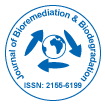Cutting-Edge Approaches in Pollutant Biodegradation and Bioremediation: Applications and Emerging Technologies
*Corresponding Author: Jenny Hong, National Engineering Technology Research Center for Desert-Oasis Ecological Construction, Xinjiang Institute of Ecology and Geography, China, Email: jennyhong1@gmail.comReceived Date: Jan 01, 2025 / Published Date: Jan 30, 2025
Citation: Jenny H (2025) Cutting-Edge Approaches in Pollutant Biodegradationand Bioremediation: Applications and Emerging Technologies. J BioremediatBiodegrad, 16: 661.
Copyright: © 2025 Jenny H. This is an open-access article distributed under theterms of the Creative Commons Attribution License, which permits unrestricteduse, distribution, and reproduction in any medium, provided the original author andsource are credited.
Abstract
The growing concern over environmental pollution has prompted the need for innovative and sustainable solutions B i o to mitigate the effects of hazardous pollutants. Biodegradation and bioremediation have emerged as effective, eco friendly approaches for the removal of a wide range of pollutants, including organic contaminants, heavy metals, and industrial chemicals. This review explores cutting-edge approaches in pollutant biodegradation and bioremediation, focusing on the latest advancements in technology and their applications. It discusses emerging bioremediation strategies such as synthetic biology, nanotechnology, and microbial consortia that enhance the efficiency and scalability of pollutant removal processes. The paper also examines novel techniques like bioaugmentation, biostimulation, and phytoremediation, highlighting their potential in addressing both established and emerging pollutants. Additionally, it addresses the challenges faced in the practical application of these technologies, including issues related to environmental conditions, scalability, and regulatory concerns. This review provides an overview of the current state of research in pollutant biodegradation and bioremediation, offering insights into future directions for advancing these technologies.

 Spanish
Spanish  Chinese
Chinese  Russian
Russian  German
German  French
French  Japanese
Japanese  Portuguese
Portuguese  Hindi
Hindi 
